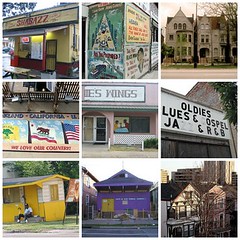St. James Infirmary: The Edifice Complexity

So, where was the St. James Infirmary? The St. James Infirmary, I mean. This is a question many fans of the song have speculated about, in one way or another.
I touched on this very briefly in the most recent version of the "St. James Infirmary" essay. There was, it is said, a St. James Methodist Church across the street from a New Orleans bar where Jelly Roll Morton used to hang out -- but that's not it, of course, as the lyric pre-dates Storyville by many years. Sarah Vowell once wrote that her "researches found a St. James Infirmary in Dublin as far back as 1667," but the hospital she seems to refer to wasn't actually known as St. James until the early 1970s. What I say in the essay is that Kenneth S. Goldstein, in the notes accompanying the 1960 Folkways record, "The Unfortunate Rake: A Study in the Evolution of a Ballad," asserts that St. James Hospital was in London, and treated lepers.
Since I just have one sentence on this in the essay, here's a more detailed summation of what Goldstein wrote almost half a century ago. It is from Goldstein's notes that I learned that oldest "Rake" texts date back to 19th century England and Ireland, and it's unclear how long the song had been around by then (maybe since 1790, possibly longer). He also writes that it is "a bitter historical irony that the 'St. James Hospital' which provides the setting for this series of ballads is known today in London as St. James Palace... The original St. James Hospital was a religious foundation for the redemption of 'fourteen sisters, maidens, that were leperous, living chastley and honestly in divine services." Henry VIII "acquired" these grounds in the early 1530s -- and if you're curious, there's more about the Palace history on "The Official Website of the British Monarchy."
Goldstein continues: "A contemporary says that the palace 'looked more like a prison than a royal mansion.' ... Palace life was a frequent subject for popular comment ... The Mall in St. James Park continued to be the most fashionable promenade in London as late as the middle of the 18th century."
Now, however, comes interesting correspondence from Paul Goddard of Bristol, England, that challenges Goldstein's assertion. Mr. Goddard suggests that, given the time frame outlined above, a more likely site for the St. James is actually St. James' workhouse, built on Poland Street in London in 1728. (I don't know a tremendous amount about workhouses, but as I understand it they came about as a result of the bluntly named "Poor Law." Mr. Goddard points me to this link, with excerpts from a 1732 publication called "An Account of Several Workhouses." Referring to a workhouse "for the able-bodied poor," erected by the parish of St. James, it reads in part:
There are 8 Wards, viz. 4 for Women, 2 for Men, 1 for Boys, and 1 for Girls .... There is one Ward for Lying-in-Women, into which many are brought out of the Streets to be deliver'd. Another Ward for an Infirmary, where, though it is generally full of Sick People, the Women that are well, are very officious to give all the Attendance they are able, under the direction of a diligent Matron ....
I would say that I think it's plausible that a folk singer might have been referencing this place, or the (mis)remembered hospital on the grounds where St. James Palace was built. It's not, after all, as if folk songs ever went through a fact-checking process: Even in real time, they could be a mishmash of past, present, and myth. And of course when you add a few hundred years of distance, reflected only through fragmentary evidence, it gets even harder to pretend one can say with confidence where the real St. James Infirmary was.
That said, Mr. Goddard's contribution here is pretty compelling. And, more important to me, it's wonderful. I like to imagine St. James Infirmary was all the places alluded to above, and many more, and none of them. If you see what I mean.
Mr. Goddard has led a Bristol band called Dr. Jazz that has performed "St. James Infirmary" many times (once on BBC2, even) over the past twenty years or so. The Dr. Jazz web site is being updated, and when that's done, a link will be provided.



<< Home